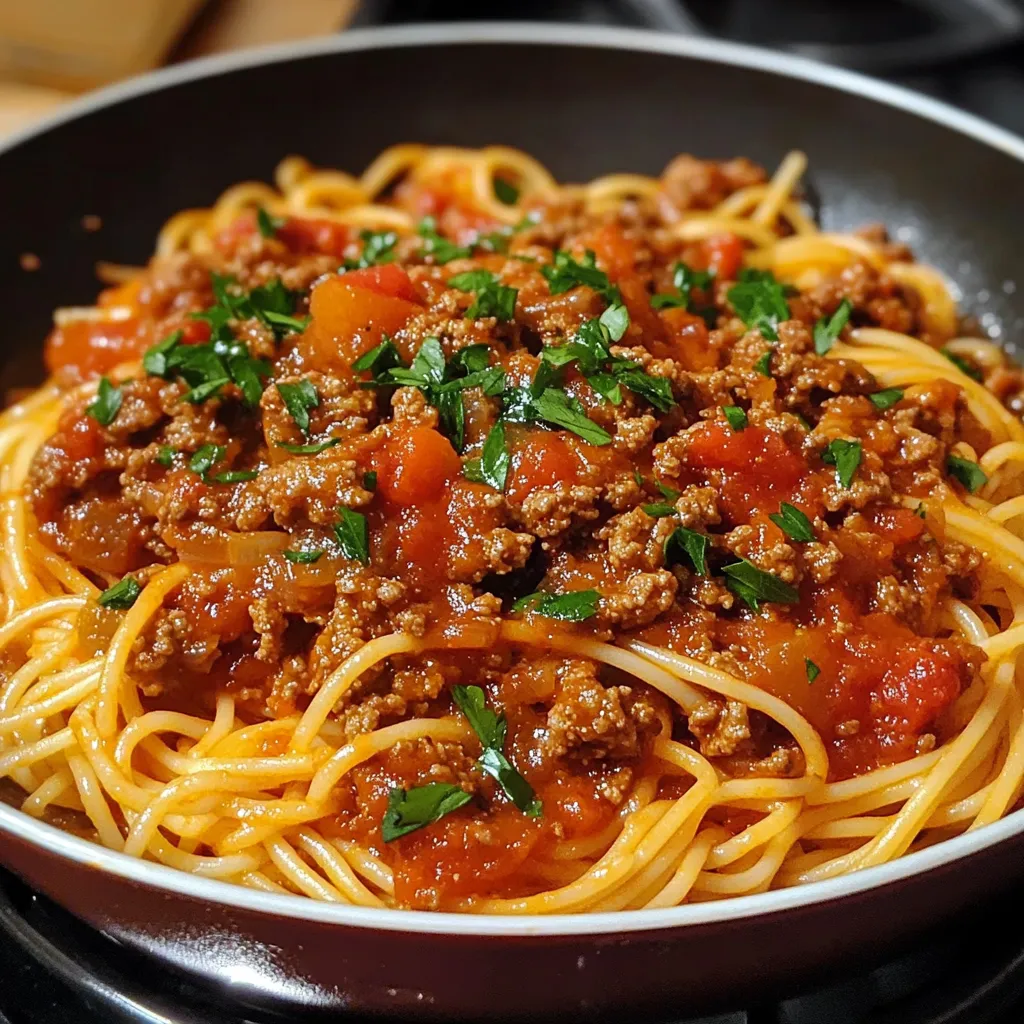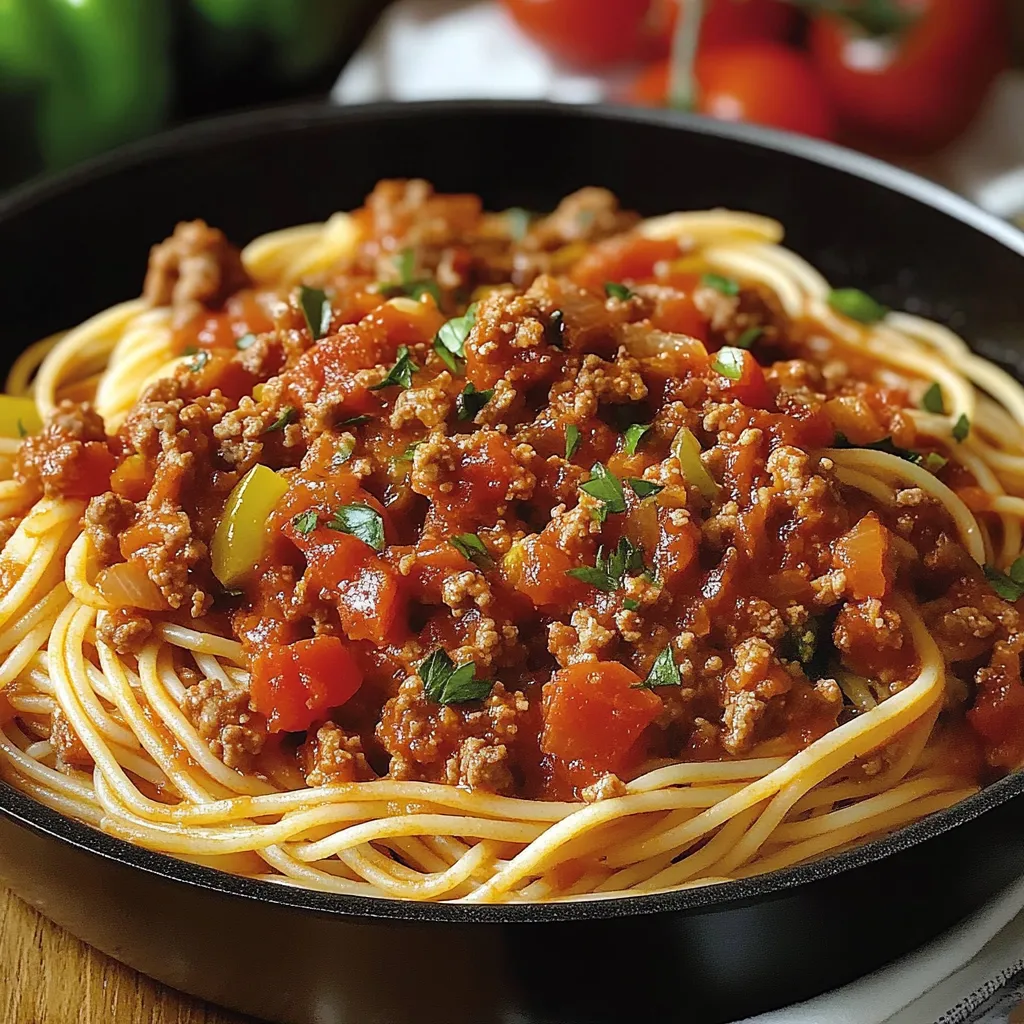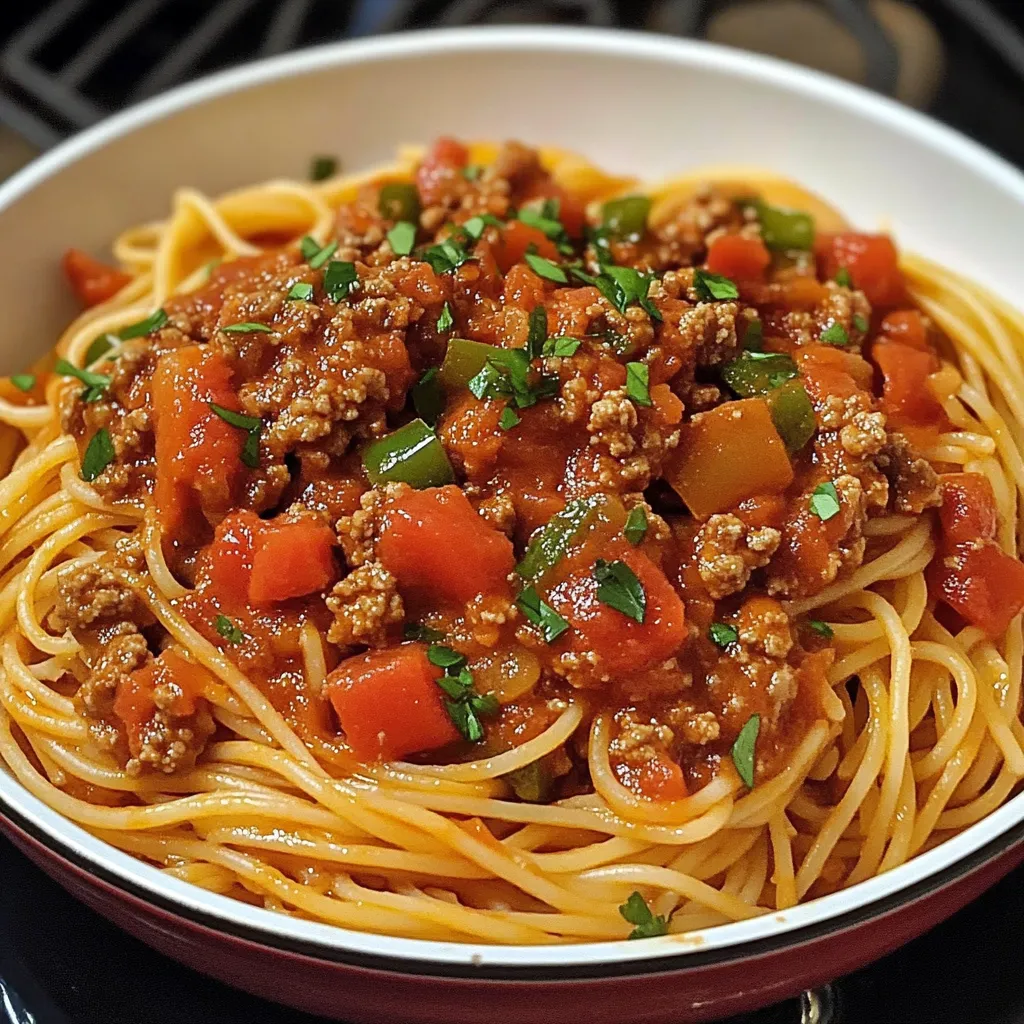 Pin it
Pin it
This skillet spaghetti recipe has been passed down through generations in my family, bringing warmth and comfort to our dinner table for decades. The rich tomato sauce, perfectly seasoned ground beef, and tender pasta come together in one magnificent dish that never fails to satisfy even the pickiest eaters.
I first discovered this recipe while helping my grandmother prepare Sunday dinners when I was just a child. The way she effortlessly brought these simple ingredients together to create something so delicious inspired my love of cooking that continues to this day.
Ingredients
- Ground chuck: Adds the perfect fat content for a rich meaty flavor
- Diced tomatoes: Provide texture while crushed tomatoes create body in the sauce
- Tomato sauce: Brings everything together with smooth consistency
- Olive oil: Helps bloom the flavors of the aromatics
- Fresh garlic: Offers more vibrant flavor than pre-minced alternatives
- Onions and green peppers: Create the aromatic foundation
- Garlic powder and onion powder: Enhance the fresh ingredients with deeper undertones
- Fresh parsley: Brightens the heavy sauce
- Dried herbs: Including basil, oregano, and Italian seasoning provide classic Italian flavor notes
- Sea salt: Enhances all the flavors while black pepper adds subtle heat
Step-by-Step Instructions
- Sauté the Aromatics:
- Heat your largest skillet over medium heat and add the olive oil until it shimmers. Add your diced onions and green peppers, cooking them until they become translucent and slightly soft, about 5 to 7 minutes. The vegetables should cook down considerably and begin to release their sweet aroma. Add the minced garlic during the last minute of cooking, stirring constantly to prevent burning. The garlic should become fragrant and just barely golden around the edges.
- Brown the Meat:
- Add the ground chuck to the aromatic vegetable mixture, breaking it apart with a wooden spoon into small crumbles. Cook until no pink remains, about 7 to 8 minutes, stirring occasionally. The meat should develop some caramelized brown spots which add tremendous flavor. Once fully cooked, carefully drain the excess fat from the pan while retaining all the flavorful bits.
- Season and Add Tomatoes:
- Sprinkle all the seasonings evenly over the browned meat, stirring thoroughly to distribute the herbs and spices. This allows the aromatics to bloom directly on the meat before the liquid ingredients are added. Pour in the crushed tomatoes, diced tomatoes, and tomato sauce, stirring well to combine everything. Make sure to scrape the bottom of the pan to incorporate any browned bits into the sauce.
- Simmer the Sauce:
- Reduce the heat to low until the sauce barely bubbles. Allow it to simmer uncovered for a full hour, stirring occasionally to prevent the bottom from scorching. The sauce will gradually thicken and the flavors will meld together beautifully. You may notice the color deepening to a rich red as it reduces. This patience is rewarded with incredible depth of flavor.
- Cook the Pasta:
- About 15 minutes before the sauce is finished, bring a large pot of generously salted water to a rolling boil. Add the spaghetti along with a tablespoon of olive oil to prevent sticking. Cook for 7 to 8 minutes until al dente. The pasta should have a slight firmness in the center. Drain thoroughly but do not rinse, as the starch helps the sauce adhere.
- Combine and Serve:
- Add the cooked spaghetti directly to the sauce, using tongs to gently toss until every strand is coated. The pasta will absorb some of the sauce as it sits. Portion into warmed bowls and garnish with additional fresh parsley if desired.
 Pin it
Pin it
The dried sweet basil is truly the secret ingredient in this recipe. My grandmother always insisted on using it specifically rather than regular dried basil, claiming it brought out the natural sweetness of the tomatoes without needing to add sugar. I remember her carefully measuring it with her wooden spoon, explaining that proper seasoning was the difference between good food and unforgettable food.
Make Ahead Options
The meat sauce portion of this recipe actually improves with time, making it perfect for meal planning. You can prepare the sauce up to three days in advance and store it in the refrigerator in an airtight container. When ready to serve, simply reheat the sauce gently on the stovetop while you cook fresh pasta. This approach often results in even more developed flavors as the herbs and spices have more time to blend with the tomatoes and meat.
Perfect Pairing Suggestions
This hearty skillet spaghetti pairs beautifully with a simple green salad dressed with olive oil and lemon juice. The acidity helps cut through the richness of the meat sauce. A loaf of crusty garlic bread makes an ideal accompaniment for sopping up every last bit of sauce. For beverages, choose a medium-bodied red wine like Chianti or Sangiovese if serving adults, or a sparkling water with lemon for a refreshing contrast to the robust flavors of the dish.
Ingredient Substitutions
While ground chuck provides the best flavor with its 80/20 fat ratio, you can substitute ground turkey for a lighter version. Just add an extra tablespoon of olive oil to compensate for the reduced fat content. For a vegetarian adaptation, replace the meat with two cups of finely chopped mushrooms and a can of drained lentils. The sauce can be made gluten-free by serving over zucchini noodles or gluten-free pasta instead of traditional spaghetti. Fresh herbs can replace dried at a ratio of three times the amount called for in the recipe.
 Pin it
Pin it
Frequently Asked Questions
- → Can I use ground turkey instead of ground beef?
Yes, ground turkey is a great substitute for ground beef in this dish. It offers a leaner option while still absorbing the flavors of the sauce.
- → How can I make this dish vegetarian?
To make this dish vegetarian, simply omit the ground meat and add your favorite plant-based protein, such as lentils, mushrooms, or a meat substitute.
- → Can I use fresh tomatoes instead of canned?
Yes, you can use fresh tomatoes! Simply peel and dice about 1.2kg of fresh tomatoes to replace the canned ones. Adjust simmering time for optimal flavor.
- → What type of spaghetti works best for this dish?
Standard spaghetti works wonderfully, but you can also use whole wheat or gluten-free pasta if you prefer. Adjust cooking times accordingly.
- → How do I store leftovers?
Store leftovers in an airtight container in the refrigerator for up to 3 days. Reheat on the stovetop or microwave, adding a splash of water to refresh the sauce.
- → Can I freeze this dish?
Yes, the sauce can be frozen separately for up to 3 months. Thaw overnight in the refrigerator and reheat on the stovetop. Cook fresh pasta when ready to serve.
